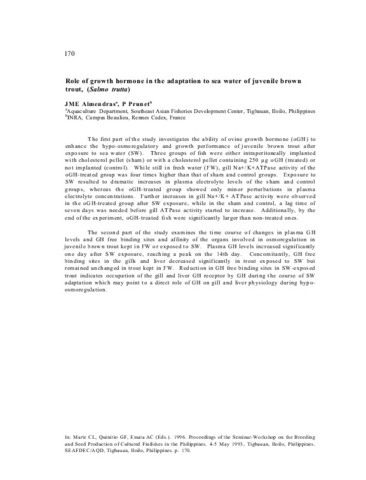Growth pattern of the tropical sea cucumber, Holothuria scabra, under captivity
- Global styles
- MLA
- Vancouver
- Elsevier - Harvard
- APA
- Help
Share
Abstract
The growth of the juvenile sea cucumber, Holothuria scabra, was studied under captivity to elucidate the growth variation pattern and determine the best-fit growth model to estimate age- and size-specific growth rates. Individual growth was extremely variable, with some individuals below the mean initial weight and some expanding their original body length (L) and weight (W) by up to 6.4 and 156 times, respectively; during 84 days of culture starting at 127 days of age. Some of the smallest individuals showed a higher condition factor than larger individuals in the presence of ample food, indicating that lack of food may not be the only impediment to growth. Among the three growth models compared (von Bertalanffy, Gompertz and logistic), the Gompertz model was considered optimal to express H. scabra growth; both in L and W. The age- and size-specific daily growth rate for L and W up to 365 days of age, as estimated by the Gompertz model, had a range of two and nine orders of magnitude in L (0.035 – 0.96 mm/day) and W (3.4 × 10-7 – 3.5 g/day), respectively. Use of the Gompertz model over the linear model, which tends to overestimate growth rates, is encouraged to estimate the growth of H. scabra more accurately.
Suggested Citation
Watanabe, S., Sumbing, J., & Lebata-Ramos, M. J. H. (2014). Growth pattern of the tropical sea cucumber, Holothuria scabra, under captivity. Japan Agricultural Research Quarterly , 48(4), 457-464. https://doi.org/10.6090/jarq.48.457
Type
ArticleISSN
0021-3551; 2185-8896Collections
- Journal Articles [1258]
Related items
Showing items related by title, author, creator and subject.
-
Role of growth hormone in the adaptation to sea water of juveline brown trout, (Salmo trutta)
Almendras, J. M. E.; Punet, P. (Aquaculture Department, Southeast Asian Fisheries Development Center, 1996)The first part of the study investigates the ability of ovine growth hormone (oGH) to enhance the hypo-osmoregulatory and growth performance of juvenile brown trout after exposure to sea water (SW). Three groups of fish ... -
Improved growth performance of Gracilariopsis heteroclada via short-term nitrogen enrichment
This study examined the effect of short-term nitrogen (N) enrichment on Gracilariopsis heteroclada growth and agar quality. Planting materials were soaked in different concentrations of ammonium chloride (NH4Cl) ... -
Growth of juvenile milkfish Chanos chanos in a natural habitat
A population of juvenile milkfish, C. chanos (Forsskaal) was studied in a small mangrove lagoon in Naburut Island, central Philippines. Several size groups of milkfish occurred in the lagoon as a result of its periodic ...






